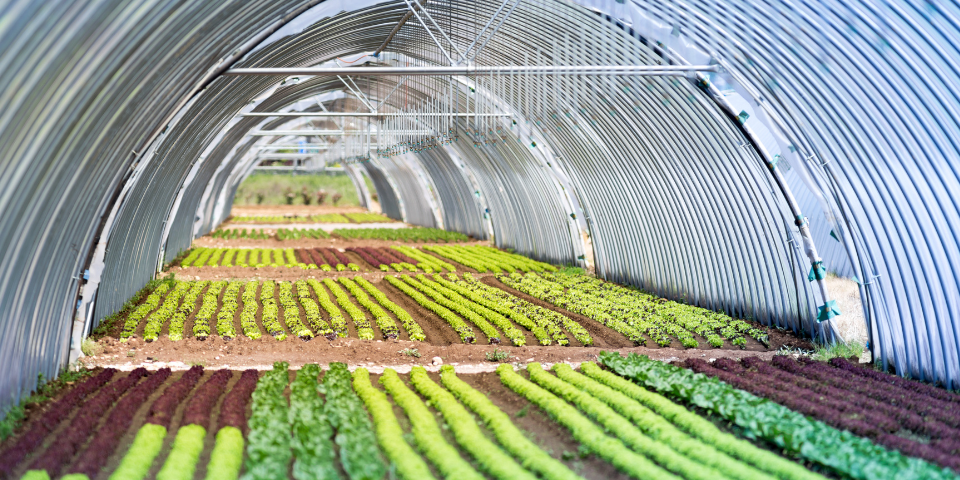
Shading nets
and anti-insect
PRODUCT TYPES
BREEDING (chickens, cattle, fish farming)
HOW WE MAKE THEM
We have local teams and we plan and execute turnkey projects.

Anti-Aphid Netting
PME 2010
Colour: crystal
Composition Urdi/Trama: 20 x 10
The PME 2010 anti-aphid netting is a specialised component in agriculture used to prevent aphid infestation, which are small insects that can seriously damage crops by feeding on plant sap and transmitting diseases. Let’s see in detail the characteristics of this netting:
- Name and Type: Anti-Aphid Netting, this netting is specifically designed to protect crops from aphids, making it ideal for preventing pests and promoting healthy plant growth. Aphids can be a considerable threat in agriculture, and this netting is an effective tool to counteract their presence.
- PME Code 2010: The code “PME 2010” is a specific designation to identify and differentiate this type of netting within the industry. It can provide additional information on the technical characteristics of the netting, such as its strength or filtration capacity, which can be useful for farmers when selecting the right product.
- Colour: Crystal, the colour “crystal” suggests that this mesh is transparent or almost invisible. This has significant advantages, as it allows sunlight to reach the plants unobstructed, which is important for plant growth. In addition, being transparent, growers can monitor the status of their crops without having to remove the netting.
- Urdi/Weft Composition: 20 x 10, the composition 20 x 10 indicates that this netting is woven with 20 threads in the warp direction (longitudinal threads) and 10 threads in the weft direction (transverse threads) per square inch or square metre. This specification provides information on the yarn density of the mesh, which influences its durability and ability to withstand adverse weather conditions such as wind and rain. Higher thread density in the warp direction may indicate greater strength and longevity of the product.
In summary, PME 2010 aphid netting with a “crystal” colour and a 20 x 10 composition is an effective option for protecting crops from aphids and other pests without compromising the plants’ exposure to sunlight. The transparency of the netting is an important feature, as it allows plants to receive the light necessary for growth while providing an effective barrier against harmful insects. The choice of an appropriate yarn density in its composition ensures its durability and long-term performance in agriculture.

Shading Netting 65%
SB: 65%
Col0ur: Green
Urdi/weft composition: 5 x 7
Shading netting 65%, often abbreviated as “SB 65%”, is an essential component in agriculture to protect crops from excessive solar radiation and the harmful effects it can have on plant development. Let’s see in detail the characteristics of this shading net:
- Shading Percentage (65%): The figure “65%” refers to the percentage of shade that this mesh provides. This means that when installing this shading net, approximately 65% of the sunlight is filtered or blocked, resulting in a significant reduction in the intensity of direct solar radiation. This level of shade is considered intermediate and has been shown to be optimal for protecting plants without completely depriving them of the light necessary for photosynthesis.
- Colour: Green, shade netting is usually available in several colours, and in this case, it has been specified as green. Green is a common choice because it blends well in agricultural settings and blends in with the landscape, making it aesthetically pleasing.
- Urdi/weft composition: 5 x 7, This specification refers to the structure of the mesh and the density of its yarns. The notation “5 x 7” indicates that the mesh is composed of 5 threads in the warp direction (longitudinal threads) and 7 threads in the weft direction (transverse threads) per square inch or square metre, depending on the unit of measurement used. This thread density is an important characteristic as it influences the strength of the mesh and its ability to withstand adverse weather conditions such as wind and rain.
This type of netting is a suitable choice for protecting crops from excessive solar radiation, providing an intermediate shade that allows an optimal balance between plant protection and the need for sunlight for healthy growth. The choice of the 5 x 7 composition ensures that the netting is durable and strong, which is essential for long-term use in agriculture.

Shading netting 85%
SB: 85%
Colour: Green
Composition Urdi/Trama: 5 x 7
Shading netting 85% SB 85% is an essential product in agriculture designed to protect crops from the harmful effects of excessive solar radiation. Let’s take a closer look at the characteristics of this shading net:
- Percentage Shade (85%): The specification “85%” refers to the percentage of shade provided by this shading net. This means that, when installing this mesh, about 85% of the sunlight is filtered or blocked, resulting in a significant reduction in the intensity of direct solar radiation. An 85% shade is considered quite high and is ideal for situations where extensive sun protection is needed for plants, such as in extremely sunny climates or for crops that are sensitive to direct light.
- Colour: Green is a common choice for shading nets in agriculture. In addition to its aesthetic appearance in the agricultural environment, the green colour also provides an additional cooling effect by reflecting part of the solar radiation and therefore helps to maintain a more moderate temperature under the mesh.
- Urdi/weft composition: 5 x 7, This specification describes the structure of the netting and the density of yarns in its weave. A “5 x 7” means that there are 5 threads in the warp direction (the longitudinal threads) and 7 threads in the weft direction (the transverse threads) per square inch or square metre, depending on the unit of measurement used. This thread density is an important characteristic as it influences the strength of the mesh and its ability to withstand adverse weather conditions, such as wind and rain, and ensures a long service life.
85% shade netting is particularly useful in situations where sun protection is critical, as it blocks a significant amount of direct solar radiation. This can help prevent burns and damage caused by excessive light and heat on plants, which can be especially important in hot, sunny climates. Choosing a yarn density of 5 x 7 ensures that the netting is durable and able to withstand long-term field conditions, providing effective crop protection and contributing to an optimal growing environment.

Anti-slip netting 16×10
Colour: Black
Urdi/Trama Composition: 16×10
The 16×10 thrips netting is an important component in agriculture that is used to prevent the infestation of thrips, which are tiny, long-bodied insects that feed on plant tissue, causing significant damage to crops. In the following, I will detail the relevant characteristics of this netting:
- Name and Function: Anti-Tips Netting, this netting is specifically designed to protect crops from thrips, which can be a devastating pest in agriculture. Thrips cause damage by feeding on plants, resulting in discoloured, deformed or silvery leaves, which reduces the quality and yield of crops. Thrips netting becomes an effective barrier to prevent these insects from gaining access to plants.
- Colour: Black is a common choice for this type of agricultural netting.
- Urdi/Weft Composition: 16×10, the specification “16×10” refers to the structure of the mesh and the density of yarns in its weave. It means that the mesh is composed of 16 threads in the warp direction (longitudinal threads) and 10 threads in the weft direction (transverse threads) per square inch or square metre, depending on the unit of measurement used. This thread density is critical as it influences the strength of the netting and its ability to keep thrips and other insect pests at bay.
Thrips netting is essential to protect crops from damage caused by thrips, a common pest in agriculture. The choice of a specific mesh structure, such as 16×10, ensures its effectiveness in blocking these insects while allowing light, air and moisture to enter for healthy plant growth. In addition, their use in greenhouses or fields reduces the need for chemical pesticides, which benefits the environment and crop health.



Make an appointment
Speak to an advisor.
